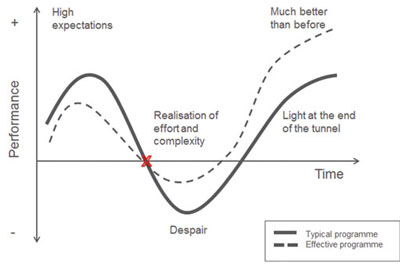5 The change curve
Change does not happen in a linear way. Those who have studied change show that the change curve in Figure 6 is indicative of our response to change. The trouble is that in any school there are many different individuals who will go through the process at different rates: some may be at the end of the process when others are still at the beginning. The important message for the leader is that you observe carefully how individuals and groups are responding to the change and take appropriate actions to support (or challenge at times) those who are finding it especially difficult to adjust to change.
At the start of the change process there is often enthusiasm, interest and optimism, leading to an improvement in performance for many. As the change is understood and the recognition of all the complexities in performance grows, confidence can drop and performance levels fall in what is known as the ‘dip’. This is normal, but the leader can do much to ensure that this dip is neither too deep nor too long-lasting.
Some of the ways a leader can minimise the dip are as follows:
- Observe and listen: The most important thing a leader can do is to observe and listen. It is still important to look beyond the change group and have conversations with individuals or groups about their concerns. By listening you will encourage trust in you and in the change.
- Optimism: The leader must keep communicating the vision and be optimistic about achieving outcomes. At times, as a leader you may experience doubt – but this should not be shared, as it is likely to reduce confidence.
- Adjustment: Your vision for the change should not alter, but you should be able to make adaptations and adjustments along the way that take account of conversations and emerging issues.
- Do not plan in too much detail at the start: Fullan (2013), perhaps the leading western educational researcher of change, suggests that plans should be ‘skinny’ and not include too much detail at the start. Coyne (2014) writes that ‘people are hard to predict. And therefore looking far ahead in time at how they might behave in response to a change you haven’t started to implement is dangerous and, at best, guesswork.’
- Quick wins: Look for early signs of success, and publicise and celebrate these. This not only promotes confidence but also the commitment to be part of something that is being seen as successful.
Case Study 6: Introduction of activity-based learning
In 2004, India’s government introduced ‘activity-based learning’ (ABL). In 2004/5, states provided training programmes for all teachers and there was enthusiasm for the initiative. By 2007/8, people were beginning to realise that ABL was more difficult to implement than they thought. By 2008, teachers in many areas had given up and resorted to more traditional methods. The ‘high expectations’ and enthusiasm slipped into ‘despair’.
Implementing a programme that requires all teachers in all schools to change is hugely ambitious. Sustainable change has to take place gradually and needs to involve the people who are responsible for implementing it.
The TESS-India materials – freely available online – will help teachers to make small changes that will bring about improvements in their classrooms. The videos show participatory teaching approaches in action in Indian classrooms. These resources will help you and your teachers to move beyond the ‘dip’ to real improvements in teaching and learning.
4 Monitoring the change

